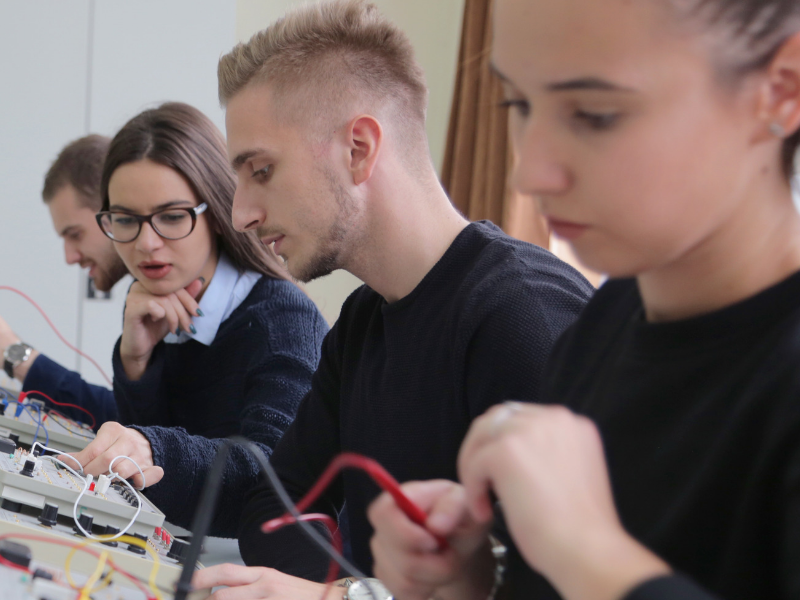
by David Bass | Apr 17, 2019
The economy is booming: Employment is at record-breaking levels, and income and wages are finally rising again. Yet something is missing. Despite all the positive economic news, a significant percent of Georgians (and Americans broadly) have been left behind.
This group of the economically lost and destitute is the subject of a new book called The Once and Future Worker: A Vision for the Renewal of Work in America, written by Oren Cass, a think tanker and former advisor to Mitt Romney. Cass includes a number of viable solutions to America’s workforce woes in his book.
We know the unfortunate numbers: Even though gross domestic product tripled between 1975 and 2015, median wages haven’t budged. During that same time, government spending on the social safety net quadrupled. Even though our economy as a whole is more productive, many Americans haven’t seen a real rise in wages, while many others have fallen into the social-safety-net system.
This has created a type of society where many people have access to iPhones and other electronic devices once considered luxuries, but fewer and fewer have access to fruitful work, a good education, and a healthy family life. As Cass puts it, during the past few decades, “Cheap goods and plentiful transfer payments ensured that nearly all Americans could afford cable television and air conditioning, but not that they could build fulfilling lives around productive work, strong families, and healthy communities.”
Cass makes a number of recommendations to ameliorate the problem, several of which dovetail with policy prescriptions from the Georgia Center for Opportunity (GCO).
One of them is to emphasize alternative pathways to work aside from the traditional college route. The fact of the matter is that attempting universal college completion for all is an unrealistic goal—even though Millennials are the most college-educated generation in history, only 40 percent of them have college degrees. Looking across all generations now alive, the vast majority of Georgians lack a four-year (or higher) college degree. Doesn’t it make sense that we should tailor more training solutions to this majority?
For a solution, Cass suggests the reintroduction of “tracking” into our educational lexicon, where one pathway leads toward college enrollment and another “toward occupational training that leaves a twenty-year-old with serious work experience, a marketable skill, and $30,000 in a savings account.” That is a far more favorable outcome than the reality too often true for Millennials today: burdensome student loan debt with a college credential that increasingly lacks labor-market value. GCO invests in these types of pathways through our apprenticeships emphasis.

by Georgia Center for Opportunity | Oct 12, 2018
Peachtree Corners—A new poll released by the Georgia Center for Opportunity (GCO) has found that a significant majority of likely Georgia voters—to the tune of 68 percent—support school choice for families across the state.
Ahead of the 2019 legislative session, nearly seven-in-ten (67 percent) voters say it’s important for the state legislature to enact policies that expand school choice in the next legislative session, and that support extends across party, racial, and geographic lines. Of all school choice measures available in Georgia, the Tax Credit Scholarship Program garnered the most support.
Underscoring the bipartisan nature of school choice, the survey found strong support for school choice regardless of political affiliation—75 percent of Republicans, 65 percent of Independents, and 62 percent of Democrats. Support is strong across racial and geographic lines as well: 70 percent of African-American voters and 66 percent of white voters support school choice, while voters in Augusta (76 percent), Atlanta (68 percent), and Savannah (65 percent) are also supportive.
“School choice has long been, and continues to be, a winning issue,” said Randy Hicks, GCO’s president and CEO. “No matter who’s leading under the Gold Dome in 2019, Georgians recognize its importance for creating a better tomorrow for every child, but particularly those from disadvantaged backgrounds who need help the most.”
The survey was conducted by WPA Intelligence. Interviews were collected from September 19-23 among over 600 likely voters in Georgia. The margin of error was plus or minus 4 percent.
Get more details about the poll here: GCO Poll Memo

by Georgia Center for Opportunity | Sep 24, 2018
A new poll from Education Next shows a surge in support for educational choice programs nationwide. Across the board, support is up for publicly funded school-choice scholarships, tax-credit scholarships, and public charter schools.
And not only is public support for school choice on the rise, it has jumped from plurality to majority support on several key data points:
- Support for publicly funded school-choice scholarships jumped from 45% in 2017 to 54% in 2018. More parents than ever support these scholarships—61%, up from 52% in 2017.
- While 43% support school-choice scholarships for low-income students, 56% of African American and 62% of Hispanic respondents favor them.
- Hispanic families in particular see the benefits of educational choice, with support for publicly funded school-choice scholarships increasing from 49% in 2017 to 67% in 2018.
Other insights:
- Support for public charter schools increased from 39% in 2017 to 44% in 2018.
- Opposition to publicly funded school-choice scholarships has decreased 13 percentage points since 2016, from 44% to 31% today.
While these results are good news for school-choice proponents nationwide, here in Georgia we continue to be a trendsetter in educational opportunity—ranking seventh nationally thanks to a series of school-choice laws passed since 2008, including the Tax Credit Scholarship Program and the Special Needs Scholarship Program.
All told, Georgia’s school choice programs have delivered impressive results—with more than 17,000 students benefitting in the 2016-17 school year, including 13,600 children participating in the tax credit scholarship program and 4,000 receiving tuition assistance through the Special Needs Scholarship Program.
And these programs are popular across key demographics such as political affiliation, age, and race. In Georgia, 84% of Republicans, 67% of Independents, and 55% of Democrats support school choice. Among Millennials and minorities, support is even stronger—and growing—with 74% of Latinos, 72% of African Americans, and 75% of Millennials in favor.
Even though most students will continue to be educated in traditional public schools, it’s nice to see the latest Education Next poll confirm nationally what we already know here in Georgia: School-choice options empower parents to make the best educational decisions for their children and give them the best shot to live a flourishing life.

by Georgia Center for Opportunity | Jul 25, 2018
There’s an old saying that a rising tide lifts all boats. This seems to be true in today’s booming economy—with low unemployment rates at the state and national levels translating into historical lows in communities that often lag behind. For example, economic fortunes for African Americans are showing sustained signs of improvement, with the most recent June 2018 unemployment rate coming in at 6.5 percent, up slightly from May’s all-time low of 5.9 percent.
And while improving employment prospects are certainly encouraging signs for a community that continues to experience unacceptably disparities on most socioeconomic measures compared to other groups, a new study from the American Enterprise Institute (AEI) offers even more evidence that African American men are making steady gains toward achieving the American Dream.
In Black Men Making It in America: The Engines of Economic Success for Black Men in America, well-known marriage and family researchers Brad Wilcox and Wendy Wang team up with fatherhood expert Ronald Mincy to examine the institutional engines that form the foundation for black male success.
Some key takeaways from this AEI report:
- The economic standing of black men has improved dramatically, with 57% now in the middle class or higher as adults today—up from 38% in 1960. Even better, the share of black men who are poor has fallen from 41% in 1960 to 18% in 2016.
- While higher education and full-time work are powerful engines of success for black men in America, so, too, is participation in institutions such as marriage, church, and the military.
- Contact with the criminal justice system remains a significant obstacle to success for black men. By midlife, only 28% of black men who had contact with the criminal justice system when they were young have moved into the middle or upper class, compared to 52% of black men who had no contact with the criminal justice system at a younger age.
Here at Georgia Center for Opportunity, we believe in a simple concept called the “success sequence,” which says that a good education leads to a stable job—which in turn leads to a flourishing home life and personal success.
Clearly, this AEI report reinforces GCO programs like Hiring Well, Doing Good and our Prisoner Reentry Initiative, which aim to remove barriers to opportunity and put Georgians back on a rising tide—or sequence—of success that lifts individuals, then families, out of generational poverty into flourishing communities.

by Georgia Center for Opportunity | Jul 3, 2018
What goal is more important than ensuring our most vulnerable students have the best shot at success? That’s what Georgia’s Special Needs Scholarship Program is all about. Now in its 11th year, the scholarship enables children who have special needs to transfer to another school to better meet their unique educational needs.
Over 4,500 students benefited from the program during the 2016-2017 school year, with scholarships averaging $5,722 per student.
But despite the success of the program, there is a lot more to be done. A House study committee convened in mid-June to consider updates to the program, specifically revisions contained in House Bill 801. HB 801 would make two significant updates to the Special Needs Scholarship Program—first, by giving parents more flexibility in how to best use scholarship funds on behalf of their child, and second by opening up scholarship funds to home-educated students.
In the first case, the bill would allow parents to use scholarship dollars for ongoing therapies, tutoring, or specialized equipment. This, in turn, would empower children with special needs to excel in the classroom and beyond.
Sometimes, students with special needs are lagging behind in their traditional public school environments. So, when they transition to a private school through the scholarship, they have to play catch up to get fully up-to-speed. Allowing parents to use scholarship funds for approved non-tuition expenses would go a long way toward helping these students stay on track at their new schools.
This type of change makes sense: Public schools are already required to provide in-house speech, occupational, and physical therapy for children with special needs. Granting scholarship recipients the same flexibility is wise.
At the study committee hearing on HB 801, parents made emotional appeals, asking lawmakers to open scholarship funds to homeschool families as well:
A former Gwinnett teacher now homeschooling her adopted children said they would benefit if the scholarship was opened to homeschoolers for tutoring and therapies, including speech, physical, occupational and equine. Her seven children face multiple struggles related to the chaos of their early lives and, in some cases, fetal alcohol syndrome and visual impairments, that render a traditional classroom unworkable, she explained.
An Atlanta mother said she pulled her bright daughter with autism out of a public middle school because the girl grew anxious and overwhelmed in such a big setting. Her daughter’s therapist recommended homeschooling to alleviate the anxiety. The mother’s goal is to homeschool now and then enroll her daughter in a small, flexible high school. She asked lawmakers to drop the requirement that students only qualify for the voucher after a full year in public school.
The Special Needs Scholarship Program is working for Georgia families who need help the most. But that doesn’t mean there isn’t room for improvement. By making these two changes, lawmakers would open up the scholarship program to hundreds of additional families in need of real educational options.

by Georgia Center for Opportunity | Jun 11, 2018
Imagine the challenge of raising two children with special needs. That’s the task that Jan—a small business owner in Georgia—faces in bringing up her two girls. Katie has ADHD, dyslexia, and autism spectrum disorder, and Jessica has an auditory processing disorder and ADHD.
But as Jan has discovered, while raising two children with special needs presents challenges, it also presents unique opportunities. Both Katie and Jessica were caught in a local public-school system that wasn’t meeting their needs. In fact, teachers told Jan that there was nothing they could do to help Katie—and that she would never learn to read or write—and that Jessica would never be able to pass state tests.
“I remember all the days at the bus stop crying and just telling my daughters, ‘We just have to make it through the end of the year,’” Jan shared. “If you don’t fit into the box, you fall through the cracks.”
Desperate for options, Jan turned to Georgia’s Special Needs Scholarship Program (the SB10 waiver). The program allows students with special needs to transfer to another school—traditional, charter, or authorized private—to better meet their unique educational needs. Since the scholarship program became law in 2007, nearly 25,000 students have participated, including 4,154 students for the 2015-2016 school year alone.
Due to funds through the scholarship, Katie started attending a small private school specifically designed for students with reading challenges. The results have been astounding: She now reads at grade level and is performing several grade levels above in math. Meanwhile, Jessica is excelling as well, taking advanced-level chemistry and performing several grade levels above in other subjects.
“Our experience at the private school is night and day,” Jan said. “I remember my daughter saying, ‘Mom, I don’t think I ever want to leave this school. Everyone here has a disability and it’s not a big deal.”
Today, Jan is dedicated to telling other families about the enormous blessing of the Georgia Special Needs Scholarship Program. Even so, she sees room for improvement in the program.
“If families were able to use the scholarship for other expenses needed for children with special needs—such as tutors and therapies—it would be incredibly helpful,” she said. “A lot of students also need additional help to get caught up because they were so far behind in their public schools. Flexibility in how the funding could be used would help support getting them on track at their private schools.”





